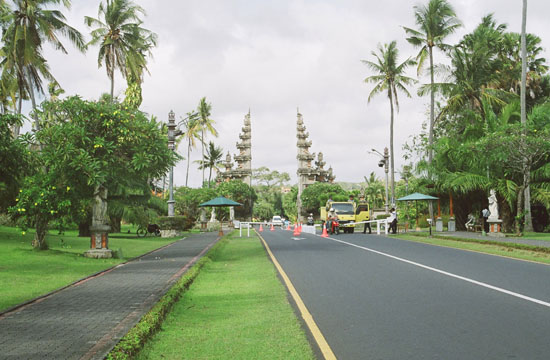Bali Gateway and Bali Door - Bali Architecture
To the untrained eye, the entrance gateway to the temple,
villages, or homes in Bali appears very much the same. A more
discerning eye will note that some gateways have a lintel, or
top covering, whilst other are left open without lintel. But the
trained eye will know and recognized the meaning and significance
of each gateway construction, whether the gateway leads to a temple
or a house or if the design is from the north of south part of
Bali and event whether the gateways leads to a Brahmana’s
(the highest Balinese caste) home or a temple.

The construction of any gateway to a home or temple is an integral
part of the surrounding boundary wall and the positioning of the
gateway is important with respect to the direction of Mount Agung,
where the mother temple, Besakih
is located.
The basic design of any gateway, be it split (open top), or
covered, is based upon a Hindu concept know as “Tri Angga”
or three part, which is related to the human body. The top (head),
center (torso) and the base (legs). This concept of Tri Angga”
is carried out beyond gateway to other objects, which have shapes
resembling the human from. It can be seen here that abstract art
has existed in Bali for more than 900 years.
Before the time that feet, inches and meters came to Bali,
the measurement relating to the actual open part of gateway were
(and still are) taken from the stature of the owner. Hands on
his hips gave the width, from elbow to elbow. One arm extended
above his head gave the height. If a Balinese never met his grandfather
the gateway to his house would tell him about grandfather’s
stature.
As a general rule, the top part of gateway is always in proportion
to the opening, just as a head is in proportion to the torso.
However the significance of the base is not always certain. Some
entranceways have one or no step, leading into the compound. Other
have three, seven, nine or even eleven step leading up and then
down into and out of the compound. Again, there are differing
theories for several steps. One being that each time we leave
or enter our compound, we are reminding that life as with the
steps is full of ups and down. Other maintain that the reason
is related to etiquette, since the gateway is often where the
owner’s head not on the same levels as his neighbor’s
then his neighbor would have to stoop as he passed by, since it
impolite in Bali to walk pat your “equal” if his head
is lower than yours.
The simple form of covered gateway (kori) can be seen in villages
away from the more commercial areas. These gateways are extremely
simple (wherein lies their beauty) and the proportions of the
base to center to top are judged as to their beauty value. The
material uses for these gateways are invariably clay brick, fired
on sun baked, rendered with clay. The top or roof can be constructed
from either timber or bamboo covered with grass, wooden tiles,
cement tiles, or bamboo tiles. On either side of many of these
simple gateways can be seen small apertures or shelves where daily
offering can be placed.
An interesting feature on some of these simple gateways is
a space between the lintel and the roof. When the doors open,
the exposed lintel symbolically resembles a wrinkle on the forehead.
Amore sophisticated construction of Kori is the “Bintang
Ariang”. This form of gateways is a natural progression
from the simple design. Above the door, the lintel space is solid
with a series of inverted steps, in many case mirror images of
the base steps are in sequences of one, three, five, etc.
The materials used are either brick or sandstone with a surface
rendering of plaster. The roof is covered with the same type as
is used for the simply gateway. This style of gateway is always
without decoration or carving, since as with the simple gate way,
the beauty value lies in the clean smooth lines perfectly balanced.
It is more usual to see this style of gateway inside the actual
compound.
What surely must rate as the grandfather of all covered gateways
is the Kori Agung (Agung means grand or lofty in style or majestic).
Here the creativeness of the Balinese stonemason can be seen at
its most imaginative. Fierce dragon-like faces with bulging eyes
or delicate flowers, gentle swirls, swastika (which are a Hindu
symbol depicting the earth’s rotation), or trees all intricately
carved into the solid stone. The top of “Kori Agung”
is high; sometimes two or tree times the height of the door resembling
a giant tiered wedding cake. A marked similarity can be seen here
to the temple offerings that are made from fruit carried by the
women of Bali on temple
festival days.
Another from of high covered gateway resembling the Balinese
men’s head dress (name after this type of head cover), is
the Kori Gelung. This form of Kori has a more squat appearance
but the decoration is just as ornate and imaginative as that of
the Kori Agung.
The materials used for both these types of Kori is either stone
or red brick are used, giving a pleasant contrast between, the
gray stone and the red brick. Some Kori Gelung(s) will be topped
with “ijuk” (a black fiber from a sugar palm) but
these types of covered gateways most often lead to the temple.
At some time in the distant Hindu past, it was decided to construct
a different type of gateway, the Candi Bentar. Here, as the name
implies (split monument), it can be seen that if the two halves
of this gateways were forced together, a perfectly symmetrical
tower would be formed. The split tower would be formed. The split
gateway can be seen every where around Bali. In fact, the first
gateway through is which a visitor passes when he arrives at Ngurah
Rai International Airport is of this design. The magnificent
Candi Bentar gateway is used extensively on the island, for hotels,
villages, places, and temples as well for homes.














